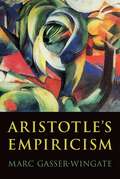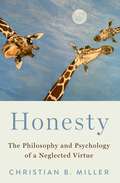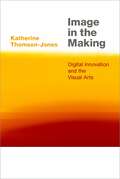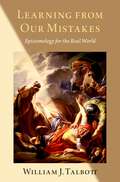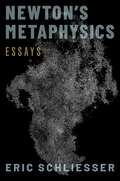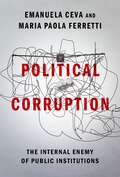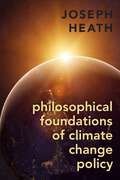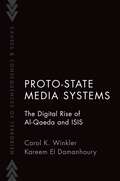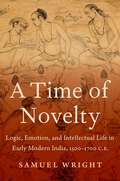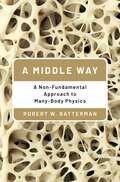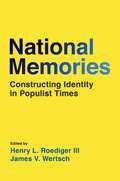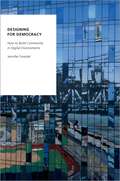- Table View
- List View
Aristotle's Empiricism
by Marc Gasser-WingateAristotle is famous for thinking that all our knowledge comes from perception. But it's not immediately clear what this view is meant to entail. It's not clear, for instance, what perception is supposed to contribute to the more advanced forms of knowledge that derive from it. Nor is it clear how we should understand the nature of its contributionwhat it might mean to say that these more advanced forms of knowledge are "derived from" or "based on" what we perceive. Aristotle is often thought to have disappointingly little to say on these matters. Gasser-Wingate makes the case that this thought is mistaken: a coherent and philosophically attractive view of perceptual knowledge can be found in the various texts in which Aristotle discusses perception's role in animal life, the cognitive resources on which it does and does not depend, and the relation it bears to practical and theoretical modes of understanding. Aristotle's Empiricism offers a sustained examination of these discussions and their epistemological, psychological, and ethical implications. It defends an interpretation of Aristotle as a moderate sort of empiricist, who thinks we can develop sophisticated forms of knowledge by broadly perceptual meansand that we therefore share an important part of our cognitive lives with nonrational animalsbut also holds that our intellectual powers allow us to surpass these animals in certain ways and thereby develop distinctively human forms of understanding.
Aristotle's Empiricism
by Marc Gasser-WingateAristotle is famous for thinking that all our knowledge comes from perception. But it's not immediately clear what this view is meant to entail. It's not clear, for instance, what perception is supposed to contribute to the more advanced forms of knowledge that derive from it. Nor is it clear how we should understand the nature of its contributionwhat it might mean to say that these more advanced forms of knowledge are "derived from" or "based on" what we perceive. Aristotle is often thought to have disappointingly little to say on these matters. Gasser-Wingate makes the case that this thought is mistaken: a coherent and philosophically attractive view of perceptual knowledge can be found in the various texts in which Aristotle discusses perception's role in animal life, the cognitive resources on which it does and does not depend, and the relation it bears to practical and theoretical modes of understanding. Aristotle's Empiricism offers a sustained examination of these discussions and their epistemological, psychological, and ethical implications. It defends an interpretation of Aristotle as a moderate sort of empiricist, who thinks we can develop sophisticated forms of knowledge by broadly perceptual meansand that we therefore share an important part of our cognitive lives with nonrational animalsbut also holds that our intellectual powers allow us to surpass these animals in certain ways and thereby develop distinctively human forms of understanding.
Honesty: The Philosophy and Psychology of a Neglected Virtue
by Christian B. MillerHonesty is an important virtue. Parents want to develop it in their children. Close relationships depend upon it. Employers value it in their employees. Surprisingly, however, philosophers have said very little about the virtue of honesty over the past fifty years. In this book, Christian B. Miller aims to draw much greater attention to this neglected virtue. The first part of the book looks at the concept of honesty. It takes up questions such as: What does honesty involve? What are the motives of an honest person? How does practical wisdom relate to honesty? Miller explores what connects the many sides of honesty, including not lying, not stealing, not breaking promises, not misleading others, and not cheating. He argues that the honest person reliably does not intentionally distort the facts as she takes them to be. Miller then examines the empirical psychology of honesty. He takes up the question of whether most people are honest, dishonest, or somewhere in between. Drawing extensively on recent studies of cheating and lying, the model Miller articulates ultimately implies that most of us have a long way to go to reach an honest character. Honesty: The Philosophy and Psychology of a Neglected Virtue provides both a richer understanding of what our character looks like, as well as what the goal of being an honest person actually involves. Miller then leaves it up to us to decide if we want to take steps to shrink the character gap between the two.
Honesty: The Philosophy and Psychology of a Neglected Virtue (The\virtues Ser.)
by Christian B. MillerHonesty is an important virtue. Parents want to develop it in their children. Close relationships depend upon it. Employers value it in their employees. Surprisingly, however, philosophers have said very little about the virtue of honesty over the past fifty years. In this book, Christian B. Miller aims to draw much greater attention to this neglected virtue. The first part of the book looks at the concept of honesty. It takes up questions such as: What does honesty involve? What are the motives of an honest person? How does practical wisdom relate to honesty? Miller explores what connects the many sides of honesty, including not lying, not stealing, not breaking promises, not misleading others, and not cheating. He argues that the honest person reliably does not intentionally distort the facts as she takes them to be. Miller then examines the empirical psychology of honesty. He takes up the question of whether most people are honest, dishonest, or somewhere in between. Drawing extensively on recent studies of cheating and lying, the model Miller articulates ultimately implies that most of us have a long way to go to reach an honest character. Honesty: The Philosophy and Psychology of a Neglected Virtue provides both a richer understanding of what our character looks like, as well as what the goal of being an honest person actually involves. Miller then leaves it up to us to decide if we want to take steps to shrink the character gap between the two.
Image in the Making: Digital Innovation and the Visual Arts (Thinking Art)
by Katherine Thomson-JonesHuman beings have always made images, and to do so they have developed and refined an enormous range of artistic tools and materials. With the development of digital technology, the ways of making images - whether they are still or moving, 2D or 3D - have evolved at an unprecedented rate. At every stage of image making, artists now face a choice between using analog and using digital tools. Yet a digital image need not look digital; and likewise, a hand-made image or traditional photograph need not look analog. If we do not see the artist's choice between the analog and the digital, what difference can this choice make for our appreciation of images in the digital age? Image in the Making answers this question by accounting for the fundamental distinction between the analog and the digital; by explicating the technological realization of this distinction in image-making practice; and by exploring the creative possibilities that are distinctive of the digital. Katherine Thomson-Jones makes the case for a new kind of appreciation in the digital age. In appreciating the images involved in every digital art form - from digital video installation to net art to digital cinema - there is a basic truth that we cannot ignore: The nature and technology of the digital expands both what an image can be as an image and what an image can be for us as human beings.
Image in the Making: Digital Innovation and the Visual Arts (Thinking Art)
by Katherine Thomson-JonesHuman beings have always made images, and to do so they have developed and refined an enormous range of artistic tools and materials. With the development of digital technology, the ways of making images - whether they are still or moving, 2D or 3D - have evolved at an unprecedented rate. At every stage of image making, artists now face a choice between using analog and using digital tools. Yet a digital image need not look digital; and likewise, a hand-made image or traditional photograph need not look analog. If we do not see the artist's choice between the analog and the digital, what difference can this choice make for our appreciation of images in the digital age? Image in the Making answers this question by accounting for the fundamental distinction between the analog and the digital; by explicating the technological realization of this distinction in image-making practice; and by exploring the creative possibilities that are distinctive of the digital. Katherine Thomson-Jones makes the case for a new kind of appreciation in the digital age. In appreciating the images involved in every digital art form - from digital video installation to net art to digital cinema - there is a basic truth that we cannot ignore: The nature and technology of the digital expands both what an image can be as an image and what an image can be for us as human beings.
Learning from Our Mistakes: Epistemology for the Real World
by William J. TalbottIn Learning from Our Mistakes: Epistemology for the Real World, William J. Talbott provides a new framework for understanding the history of Western epistemology and uses it to propose a new way of understanding rational belief that can be applied to pressing social and political issues. Talbott's new model of rational belief is not a model of a theorem prover in mathematics It is a model of a good learner. Being a good learner requires sensitivity to clues, the imaginative ability to generate alternative explanatory narratives that fit the clues, and the ability to select the most coherent explanatory narrative. Sensitivity to clues requires sensitivity not only to evidence that supports one's own beliefs, but also to evidence that casts doubt on them. One of the most important characteristics of a good learner is the ability to correct mistakes. From this model, Talbott articulates nine principles that help to explain the difference between rational and irrational belief. Talbott contrasts his approach with the approach of historically important philosophers, including Socrates, Plato, Aristotle, Hume, Kant, Wittgenstein, and Kuhn, as well as with a range of contemporary approaches, including pragmatism, Bayesianism, and naturalism. On the basis of his model of rational belief, Talbott articulates a new theory of prejudice, which he uses to help diagnose the sources of inequity in the U.S. criminal justice system, as well as to provide insight into the proliferation of tribal and fascist epistemologies based on alt-facts and alt-truth. Learning from Our Mistakes offers a new lens through which to interpret the history of Western epistemology and analyze the complicated social and political phenomena facing us today.
Learning from Our Mistakes: Epistemology for the Real World
by William J. TalbottIn Learning from Our Mistakes: Epistemology for the Real World, William J. Talbott provides a new framework for understanding the history of Western epistemology and uses it to propose a new way of understanding rational belief that can be applied to pressing social and political issues. Talbott's new model of rational belief is not a model of a theorem prover in mathematics It is a model of a good learner. Being a good learner requires sensitivity to clues, the imaginative ability to generate alternative explanatory narratives that fit the clues, and the ability to select the most coherent explanatory narrative. Sensitivity to clues requires sensitivity not only to evidence that supports one's own beliefs, but also to evidence that casts doubt on them. One of the most important characteristics of a good learner is the ability to correct mistakes. From this model, Talbott articulates nine principles that help to explain the difference between rational and irrational belief. Talbott contrasts his approach with the approach of historically important philosophers, including Socrates, Plato, Aristotle, Hume, Kant, Wittgenstein, and Kuhn, as well as with a range of contemporary approaches, including pragmatism, Bayesianism, and naturalism. On the basis of his model of rational belief, Talbott articulates a new theory of prejudice, which he uses to help diagnose the sources of inequity in the U.S. criminal justice system, as well as to provide insight into the proliferation of tribal and fascist epistemologies based on alt-facts and alt-truth. Learning from Our Mistakes offers a new lens through which to interpret the history of Western epistemology and analyze the complicated social and political phenomena facing us today.
Newton's Metaphysics: Essays
by Eric SchliesserIn this collection of new and previously published essays, noted philosopher Eric Schliesser offers new interpretations of the signifance of Isaac Newton's metaphysics on his physics and the subsequent development of philosophy more broadly. Schliesser address Newton's account of space, time, gravity, motion, inertia, and laws-all evergreens in the literature; he also breaks new ground in focusing on Newton's philosophy of time, Newton's views on emanation, and Newton's modal metaphysics. In particular, Schliesser explores the rich resonances between Newton's and Spinoza's metaphysics. Schliesser presents a new argument of the ways in which Newton and his circle respond to the treatment and accusations of Spinozism, illuminating both the details of Newton's metaphysics and the content of Spinoza's. Schliesser provides a fine-grained analysis of some of the key metaphysical concepts in Newton's physics, including controversial interpretations of Newton's ideas on space, time, inertia, and necessity. Schliesser restates his provocative interpretation of Newton's views on action at a distance as he was developing the Principia. Newton's Metaphysics contains a substantive introduction, two chapters co-authored with Zvi Biener and with Mary Domski, new chapters on Newton's modal metaphysics and his theology, and two postscripts in which Schliesser responds to some of his most important critics, including Katherine Brading, Andrew Janiak, Hylarie Kochiras, Steffen Ducheyne, and Adwait Parker. The collection presents new and varied analyses on familiar focuses of Newton's work, adding important perspectives to the recent revival of interest in Spinoza's metaphysics.
Newton's Metaphysics: Essays
by Eric SchliesserIn this collection of new and previously published essays, noted philosopher Eric Schliesser offers new interpretations of the signifance of Isaac Newton's metaphysics on his physics and the subsequent development of philosophy more broadly. Schliesser address Newton's account of space, time, gravity, motion, inertia, and laws-all evergreens in the literature; he also breaks new ground in focusing on Newton's philosophy of time, Newton's views on emanation, and Newton's modal metaphysics. In particular, Schliesser explores the rich resonances between Newton's and Spinoza's metaphysics. Schliesser presents a new argument of the ways in which Newton and his circle respond to the treatment and accusations of Spinozism, illuminating both the details of Newton's metaphysics and the content of Spinoza's. Schliesser provides a fine-grained analysis of some of the key metaphysical concepts in Newton's physics, including controversial interpretations of Newton's ideas on space, time, inertia, and necessity. Schliesser restates his provocative interpretation of Newton's views on action at a distance as he was developing the Principia. Newton's Metaphysics contains a substantive introduction, two chapters co-authored with Zvi Biener and with Mary Domski, new chapters on Newton's modal metaphysics and his theology, and two postscripts in which Schliesser responds to some of his most important critics, including Katherine Brading, Andrew Janiak, Hylarie Kochiras, Steffen Ducheyne, and Adwait Parker. The collection presents new and varied analyses on familiar focuses of Newton's work, adding important perspectives to the recent revival of interest in Spinoza's metaphysics.
Rights and Their Limits: In Theory, Cases, and Pandemics
by F.M. KammIn this volume, F.M. Kamm explores how theories as well as hypothetical and practical cases help us understand rights and their limits. The book begins by considering moral status and its relation to having rights (including whether non-human animals have rights and what rights future persons have). The author then considers whether rights are grounded in duties to oneself, which duties are correlative to rights, and whether neuroscientific and psychological studies can help determine what rights we have. Kamm next investigates the contours of the right not to be harmed by considering critiques of deontological distinctions, the costs that must be undertaken to avoid harming, and a proposal for permissibly harming someone (that allows for resisting the harm) in the Trolley Problem. Additional chapters cover possible implications of the Trolley Problem for such practical issues as correctly programming self-driving cars, providing medical treatments, and enacting redistributive economic policy. Kamm concludes the book by comparing the use of case-based judgments about extreme cases in moral versus aesthetic theory, and by exploring the significance of the right not to be harmed for morally correct policies in the extreme cases of torture and a pandemic. Where pertinent, Kamm considers the views of Derek Parfit, Tom Regan, Christine Korsgaard, Shelly Kagan, Ronald Dworkin, Amartya Sen, Allan Gibbard, Joshua Greene, Arthur Danto, and Judith Thomson, among others.
Rights and Their Limits: In Theory, Cases, and Pandemics
by F.M. KammIn this volume, F.M. Kamm explores how theories as well as hypothetical and practical cases help us understand rights and their limits. The book begins by considering moral status and its relation to having rights (including whether non-human animals have rights and what rights future persons have). The author then considers whether rights are grounded in duties to oneself, which duties are correlative to rights, and whether neuroscientific and psychological studies can help determine what rights we have. Kamm next investigates the contours of the right not to be harmed by considering critiques of deontological distinctions, the costs that must be undertaken to avoid harming, and a proposal for permissibly harming someone (that allows for resisting the harm) in the Trolley Problem. Additional chapters cover possible implications of the Trolley Problem for such practical issues as correctly programming self-driving cars, providing medical treatments, and enacting redistributive economic policy. Kamm concludes the book by comparing the use of case-based judgments about extreme cases in moral versus aesthetic theory, and by exploring the significance of the right not to be harmed for morally correct policies in the extreme cases of torture and a pandemic. Where pertinent, Kamm considers the views of Derek Parfit, Tom Regan, Christine Korsgaard, Shelly Kagan, Ronald Dworkin, Amartya Sen, Allan Gibbard, Joshua Greene, Arthur Danto, and Judith Thomson, among others.
Political Corruption: The Internal Enemy of Public Institutions
by Emanuela Ceva Maria Paola FerrettiFrom the spread of kleptocracy in Venezuela at the expense of the country's economy, to President Trump's appointment of family members to high-ranking White House positions, to President Lukashenko's desperate stranglehold on power in Belarus, across the world political corruption is rampant--indeed practically too ubiquitous to keep track of. As these examples illustrate, political corruption is often associated to a variety of instances of abuse of power that either derive from a vicious trait of individual character, or develop within deeply dysfunctional institutions. To Emanuela Ceva and Maria Paola Ferretti, however, this piecemeal view is inadequate: individual and institutional instances of political corruption have a common root that we can understand only by treating corruption and anticorruption as a matter of a public ethics of office. Political corruption is the Trojan horse that undermines public institutions from within via an interrelated action of officeholders. Even well-designed and legitimate institutions can veer off track if the officeholders fail through their conduct to uphold a public ethics of office accountability. This book offers an analytically rigorous definition of political corruption. It also investigates the common normative root of its two manifestations--corrupt individual character, and corrupt institutional mechanisms--as a relationally wrongful practice that consists of an unaccountable use of the power of office by officeholders in public institutions. From this perspective, political corruption must be understood from within, for it is an internal enemy of public institutions that can only be opposed by mobilizing the officeholders to remain accountable and mutually answerable for their conduct. In this way, anticorruption calls on the officeholders' responsibility to work together to maintain an interactively just institutional system.
Political Corruption: The Internal Enemy of Public Institutions
by Emanuela Ceva Maria Paola FerrettiFrom the spread of kleptocracy in Venezuela at the expense of the country's economy, to President Trump's appointment of family members to high-ranking White House positions, to President Lukashenko's desperate stranglehold on power in Belarus, across the world political corruption is rampant--indeed practically too ubiquitous to keep track of. As these examples illustrate, political corruption is often associated to a variety of instances of abuse of power that either derive from a vicious trait of individual character, or develop within deeply dysfunctional institutions. To Emanuela Ceva and Maria Paola Ferretti, however, this piecemeal view is inadequate: individual and institutional instances of political corruption have a common root that we can understand only by treating corruption and anticorruption as a matter of a public ethics of office. Political corruption is the Trojan horse that undermines public institutions from within via an interrelated action of officeholders. Even well-designed and legitimate institutions can veer off track if the officeholders fail through their conduct to uphold a public ethics of office accountability. This book offers an analytically rigorous definition of political corruption. It also investigates the common normative root of its two manifestations--corrupt individual character, and corrupt institutional mechanisms--as a relationally wrongful practice that consists of an unaccountable use of the power of office by officeholders in public institutions. From this perspective, political corruption must be understood from within, for it is an internal enemy of public institutions that can only be opposed by mobilizing the officeholders to remain accountable and mutually answerable for their conduct. In this way, anticorruption calls on the officeholders' responsibility to work together to maintain an interactively just institutional system.
Philosophical Foundations of Climate Change Policy
by Joseph HeathThere is widespread agreement that something must be done to combat anthropogenic climate change. And yet what is the extent of our obligations? It would clearly be unjust for us to allow global warming to reach dangerous levels. But what is the nature of this injustice? Providing a plausible philosophical specification of the wrongness of our present inaction has proven surprisingly difficult. Much of this is due to the temporal structure of the problem, or the fact that there is such a significant delay between our actions and the effects that they produce. Many normative theories that sound plausible when applied to contemporaneous problems generate surprising or perverse results when applied to problems that extend over long periods of time, involving effects on individuals who have not yet been born. So while states have a range of sensible climate change policies at their disposal, the philosophical foundations of these policies remains indeterminate. By far the most influential philosophical position has been the variant of utilitarianism most popular among economists, which maintains that we have an obligation to maximize the well-being of all people, from now until the end of time. Climate change represents an obvious failure of maximization. Many environmental philosophers, however, find this argument unpersuasive, because it also implies that we have an obligation to maximize economic growth. Yet their attempts to provide alternative foundations for policy have proven unpersuasive. Joseph Heath presents an approach to thinking about climate change policy grounded in social contract theory, which focuses on the fairness of existing institutions, not the welfare of future generations, in order to generate a set of plausible policy prescriptions.
Philosophical Foundations of Climate Change Policy
by Joseph HeathThere is widespread agreement that something must be done to combat anthropogenic climate change. And yet what is the extent of our obligations? It would clearly be unjust for us to allow global warming to reach dangerous levels. But what is the nature of this injustice? Providing a plausible philosophical specification of the wrongness of our present inaction has proven surprisingly difficult. Much of this is due to the temporal structure of the problem, or the fact that there is such a significant delay between our actions and the effects that they produce. Many normative theories that sound plausible when applied to contemporaneous problems generate surprising or perverse results when applied to problems that extend over long periods of time, involving effects on individuals who have not yet been born. So while states have a range of sensible climate change policies at their disposal, the philosophical foundations of these policies remains indeterminate. By far the most influential philosophical position has been the variant of utilitarianism most popular among economists, which maintains that we have an obligation to maximize the well-being of all people, from now until the end of time. Climate change represents an obvious failure of maximization. Many environmental philosophers, however, find this argument unpersuasive, because it also implies that we have an obligation to maximize economic growth. Yet their attempts to provide alternative foundations for policy have proven unpersuasive. Joseph Heath presents an approach to thinking about climate change policy grounded in social contract theory, which focuses on the fairness of existing institutions, not the welfare of future generations, in order to generate a set of plausible policy prescriptions.
Proto-State Media Systems: The Digital Rise of Al-Qaeda and ISIS (Causes and Consequences of Terrorism)
by Carol Winkler Kareem El DamanhouryProto-State Media Systems explores how decisions by contemporary violent extremist groups create, develop, and sustain media systems. Focusing on the cases of al-Qaeda and ISIS, this book showcases how standard media systems theory fails to fully explain the media systems of these organizations as a basis for building a revised theoretical lens that comprehends these emergent systems in the 21st century global media context. Utilizing constitutive and online networking theories, Winkler and El Damanhoury explore how militant proto-states create lasting, adaptable, identity-based systems that work to attract and sustain the attention of followers. The groups' appeals to transhistorical and transpatial identity formations in their media products reveal new insights about community formation and how we analyze media systems in the proto-state context. Recognizing that nation-states no longer exercise monopoly control over online and offline media systems, Proto-State Media Systems investigates how certain violent extremist groups bent on establishing sustained territorial and governing control over populations have revolutionized the media environment of the 21st century.
Proto-State Media Systems: The Digital Rise of Al-Qaeda and ISIS (Causes and Consequences of Terrorism)
by Carol Winkler Kareem El DamanhouryProto-State Media Systems explores how decisions by contemporary violent extremist groups create, develop, and sustain media systems. Focusing on the cases of al-Qaeda and ISIS, this book showcases how standard media systems theory fails to fully explain the media systems of these organizations as a basis for building a revised theoretical lens that comprehends these emergent systems in the 21st century global media context. Utilizing constitutive and online networking theories, Winkler and El Damanhoury explore how militant proto-states create lasting, adaptable, identity-based systems that work to attract and sustain the attention of followers. The groups' appeals to transhistorical and transpatial identity formations in their media products reveal new insights about community formation and how we analyze media systems in the proto-state context. Recognizing that nation-states no longer exercise monopoly control over online and offline media systems, Proto-State Media Systems investigates how certain violent extremist groups bent on establishing sustained territorial and governing control over populations have revolutionized the media environment of the 21st century.
A Time of Novelty: Logic, Emotion, and Intellectual Life in Early Modern India, 1500-1700 C.E.
by Samuel WrightIn A Time of Novelty, Samuel Wright re-envisions the relationship between philosophy and history in premodern India. This relationship is studied through the tradition of Sanskrit logic between 1500 and 1700 CE -- the period in Indian history that witnessed the ascendency of the Mughal Empire. During this period, Sanskrit logicians would refer to themselves and their arguments as 'new,' indicating that the concept of novelty was at the center of their philosophical project. By retaining space for emotion when studying intellectual thought,this book recovers both what it means to "think" novelty and to "feel" novelty for these thinkers. Focusing on a number of little-known essays by early modern Sanskrit logicians, Wright argues that the concept of novelty is used to forge a new philosophical community in this period where novelty is both an intellectual and affective category. This perspective allows the book to raise questions that have never been asked when studying Sanskrit logic -- questions concerning critical thought, mood, imagination, and manuscript culture. Wright expands the ways in which we study philosophical thought by considering philosophy as deeply immersed in the felt experiences of one's life, at the confluence of thinking and feeling.
A Time of Novelty: Logic, Emotion, and Intellectual Life in Early Modern India, 1500-1700 C.E.
by Samuel WrightIn A Time of Novelty, Samuel Wright re-envisions the relationship between philosophy and history in premodern India. This relationship is studied through the tradition of Sanskrit logic between 1500 and 1700 CE -- the period in Indian history that witnessed the ascendency of the Mughal Empire. During this period, Sanskrit logicians would refer to themselves and their arguments as 'new,' indicating that the concept of novelty was at the center of their philosophical project. By retaining space for emotion when studying intellectual thought,this book recovers both what it means to "think" novelty and to "feel" novelty for these thinkers. Focusing on a number of little-known essays by early modern Sanskrit logicians, Wright argues that the concept of novelty is used to forge a new philosophical community in this period where novelty is both an intellectual and affective category. This perspective allows the book to raise questions that have never been asked when studying Sanskrit logic -- questions concerning critical thought, mood, imagination, and manuscript culture. Wright expands the ways in which we study philosophical thought by considering philosophy as deeply immersed in the felt experiences of one's life, at the confluence of thinking and feeling.
A Middle Way: A Non-Fundamental Approach to Many-Body Physics
by Robert W. BattermanRobert W. Batterman's monograph examines a ubiquitous methodology in physics and the science of materials that has virtually been ignored in the philosophical literature. This method focuses on mesoscale structures as a means for investigating complex many-body systems. It challenges foundational pictures of physics where the most important properties are taken to be found at lower, more fundamental scales. This so-called "hydrodynamic approach" has its origins in Einstein's pioneering work on Brownian motion. This work can be understood to be one of the first instances of "upscaling" or homogenization whereby values for effective continuum scale parameters can be theoretically determined. Einstein also provided the first statement of what came to be called the "Fluctuation-Dissipation" theorem. This theorem justifies the use of equilibrium statistical mechanics to study the nonequilibrium behaviors of many-body systems. Batterman focuses on the consequences of the Fluctuation-Dissipation theorem for a proper understanding of what can be considered natural parameters or natural kinds for studying behaviors of such systems. He challenges various claims that such natural, or joint carving, parameters are always to be found at the most fundamental level. Overall, Batterman argues for mesoscale first, middle-out approach to many questions concerning the relationships between fundamental theories and their phenomenological, continuum scale cousins.
A Middle Way: A Non-Fundamental Approach to Many-Body Physics
by Robert W. BattermanRobert W. Batterman's monograph examines a ubiquitous methodology in physics and the science of materials that has virtually been ignored in the philosophical literature. This method focuses on mesoscale structures as a means for investigating complex many-body systems. It challenges foundational pictures of physics where the most important properties are taken to be found at lower, more fundamental scales. This so-called "hydrodynamic approach" has its origins in Einstein's pioneering work on Brownian motion. This work can be understood to be one of the first instances of "upscaling" or homogenization whereby values for effective continuum scale parameters can be theoretically determined. Einstein also provided the first statement of what came to be called the "Fluctuation-Dissipation" theorem. This theorem justifies the use of equilibrium statistical mechanics to study the nonequilibrium behaviors of many-body systems. Batterman focuses on the consequences of the Fluctuation-Dissipation theorem for a proper understanding of what can be considered natural parameters or natural kinds for studying behaviors of such systems. He challenges various claims that such natural, or joint carving, parameters are always to be found at the most fundamental level. Overall, Batterman argues for mesoscale first, middle-out approach to many questions concerning the relationships between fundamental theories and their phenomenological, continuum scale cousins.
National Memories: Constructing Identity in Populist Times
by Henry L. Roediger III James V. WertschThis volume brings together distinguished scholars to address broad societal claims about the surge in populist nationalism in the scholarly literature on collective memory. The book sets the stage by examining historical origins and case studies of populism and nationalism in the United States before exploring these phenomena in the global context. Next, the book establishes conceptual frameworks for approaching nationalism and populism in national narratives through the literature on collective memory, political psychology, history, and international studies. The book concludes with a discussion on common themes uncovered over the course of the book. Throughout each section, the book uses empirical evidence and conceptual claims to shed light on the rise in global populist nationalism in a thoughtful, comprehensive manner for scholars of a wide range of backgrounds. National Memories offers a multidisciplinary, modern approach to an old global societal challenge in a time of great political and social upheaval.
National Memories: Constructing Identity in Populist Times
by James V. Wertsch Henry L. Roediger IIIThis volume brings together distinguished scholars to address broad societal claims about the surge in populist nationalism in the scholarly literature on collective memory. The book sets the stage by examining historical origins and case studies of populism and nationalism in the United States before exploring these phenomena in the global context. Next, the book establishes conceptual frameworks for approaching nationalism and populism in national narratives through the literature on collective memory, political psychology, history, and international studies. The book concludes with a discussion on common themes uncovered over the course of the book. Throughout each section, the book uses empirical evidence and conceptual claims to shed light on the rise in global populist nationalism in a thoughtful, comprehensive manner for scholars of a wide range of backgrounds. National Memories offers a multidisciplinary, modern approach to an old global societal challenge in a time of great political and social upheaval.
Designing for Democracy: How to Build Community in Digital Environments (Oxford Studies in Digital Politics)
by Jennifer ForestalHow should we "fix" digital technologies to support democracy instead of undermining it? In Designing for Democracy, Jennifer Forestal argues that accurately evaluating the democratic potential of digital spaces means studying how the built environment--a primary component of our "modern public square"--structures our activity, shapes our attitudes, and supports the kinds of relationships and behaviors democracy requires. While many scholars and practitioners are attentive to the role of design in shaping behavior, they have yet to fully engage with the question of what structures are required to support democratic communities--and how to build them. Forestal closes this gap by providing a new theory of democratic space. Drawing from a wide range of disciplines, including architecture, psychology, and the history of political thought, she argues that "democratic spaces" must be designed with three environmental characteristics--boundaries, durability, and flexibility--that, taken together, afford users the ability to engage in fundamental civic practices. Through extended analyses of Facebook, Twitter, and Reddit, Forestal shows precisely how well these digital platforms meet the criteria for democratic spaces, or whether they do so at all. The result is a more nuanced analysis of the democratic communities that form--or fail to emerge--in these spaces, as well as more concrete suggestions for how to improve them. In connecting the built environment, digital technologies, and democratic theory, Designing for Democracy provides blueprints for democracy in a digital age.
